There’s water all around us, and it can get to your CPU through condensation. Because water is good at slipping into tiny spaces and is electrically conductive, it can easily short the CPU pins, leaving you with an expensive loss.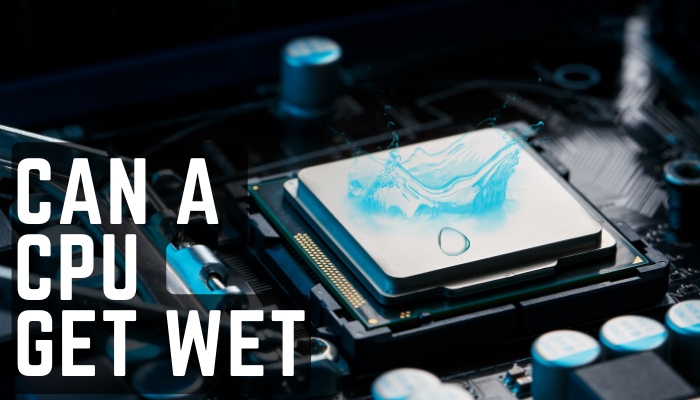
But, not all hope is lost. Oftentimes, as long as it’s freshwater rather than saltwater, you can dry out the processor before any permanent damage if you act quickly.
So, a CPU can get wet and still work like nothing happened, provided that you strictly follow the steps in this article.
Let’s begin!
What Happens When the CPU Gets Wet?
Getting water on the CPU is one of the worst things that can happen to your PC. Even a small amount can damage the processor along with the motherboard, hard drives, and optical drives. But if you quickly clean the CPU with solvent or distilled water and dry it thoroughly, it’ll be fine.
Water + Electricity = Destroyed processor.
In most cases, water by itself is harmless. It doesn’t kill your CPU; shorted-out power is the one responsible. Water only kills electronics if the current is going through it.
If you spill water on a processor that’s powered up and running, it can short-circuit the CPU pins and cause permanent damage to the electrical traces and capacitors.
But in case the CPU is turned off, you have nothing to worry about as long as you act quickly and thoroughly dry & clean the processor before using it again.
How to Determine if a Processor has Water Damage
Water damage to a CPU can result in serious problems, such as short circuits, component failure, and even permanent damage. Detecting water destruction is the first step in mitigating the problem and avoiding further damage to the processor.
Follow the instructions below to know the various methods of observing whether your processor has water damage.
Here are the steps to detect if a CPU has water damage:
Inspect the CPU for Moisture
The first step in detecting water damage to a processor is to perform a visual inspection. Check for any visible signs of water or moisture, such as water spots, condensation, or discoloration. 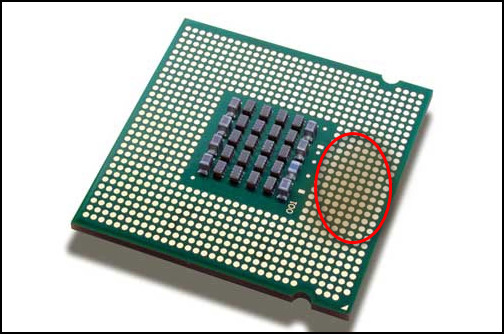
If you find any signs of water damage, it is essential to proceed with caution and take immediate steps to avoid further damage.
Corrosion
Corrosion is a common result of water damage and can cause serious problems for electronic components, including the CPU. Check for any signs of corrosion on the component surface, such as rust, green discoloration, or powdery substances. 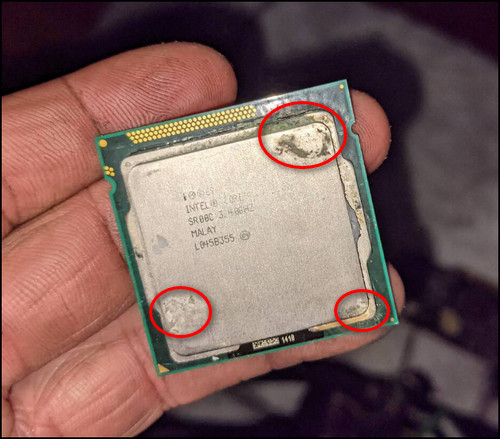
Diagnosing Components
To diagnose water damage to the CPU, it is necessary to test the component itself. This can be done by removing the processor from the motherboard and checking it for signs of damage or corrosion. You can also use a multimeter to test for continuity.
Drying Process
If your CPU has been exposed to water, it is essential to dry it as soon as possible to minimize damage. To do that, remove the processor from the motherboard and use a clean, dry cloth to gently wipe down the surface. Use a fan or a dehumidifier to help speed up the process.
Detecting water damage to a CPU can help prevent serious problems, such as component failure and permanent damage. And in case there’s water all over the processor, go to the following section, where I’ve explained the exact ways to save the CPU.
What to Do When the CPU Gets Wet?
If you spill water on the processor, quickly take it out from the motherboard. Wipe the water off with a clean paper towel dipped into isopropyl alcohol. Add heat & airflow to dry the CPU. When you are certain that the CPU is completely dry, connect it to the computer and turn it on.
Here’s what to do when the CPU gets wet:
1. Disconnect the CPU
If water falls on a CPU that’s already out of the motherboard, then there’s no chance of short-circuit, and completely cleaning the water is enough to save the processor.
However, spilling water on a CPU that’s connected to the motherboard and running, can be disastrous. In that case, you need to switch off the computer ASAP! Then take out the CPU & other components from the PC case and dry them off.
2. Dry the Processor Completely
Drying the CPU thoroughly is essential to protect it from any kind of water damage. You need to keep the processor as clean and as dry as possible before powering it back on.
Use a microfiber cloth and carefully wipe the CPU with rubbing alcohol. Drying the IHS is easy enough, but you must be extra cautious when cleaning the processor pins so as not to bend them.
Then simply follow the basic principles of evaporating water. Add heat or airflow, or preferably both, to the CPU.
But I’d avoid taking a hair dryer to it because too much heat can melt or bend the processor pins, which is bad news for the CPU. However, you can still fix the bent pins.
I also wouldn’t recommend burying the CPU in moisture-absorbing materials like rice or silica gel. Because these materials aren’t actually that absorbent.
And drying the processor in this manner can make your situation much worse when contaminants dissolved in the water build up with more density where the liquid droplets dry.
3. Clean the CPU with Isopropyl Alcohol
90% or higher Isopropyl alcohol or rubbing alcohol is a non-conductive solvent that effectively displaces water. Then evaporates very quickly at room temperature.
Lightly dip a piece of clean paper towel in isopropyl alcohol and start cleaning the CPU. Make it nice & shiny.
To clean the CPU pins, use a toothbrush with soft and plain bristles. Dip the toothbrush in isopropyl alcohol for about a minute. 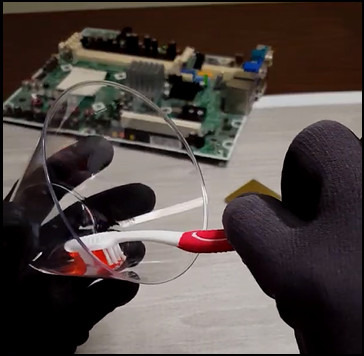
Then brush between the pins carefully. Don’t put too much pressure, otherwise, you can damage them. 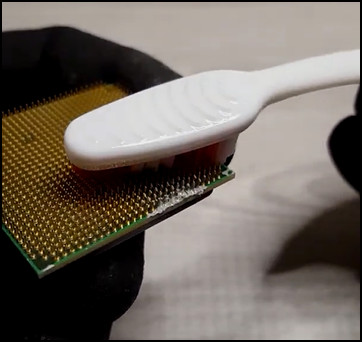
To clean the LGA CPU sockets, use a small paper towel or coffee filter paper dipped in rubbing alcohol.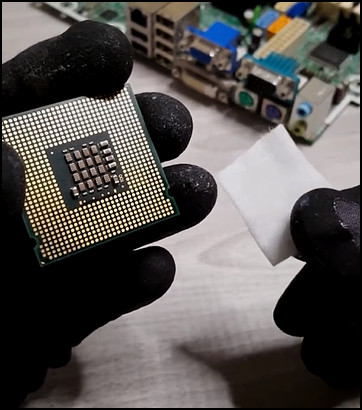
After thoroughly cleaning the processor, don’t connect it to the motherboard right away. Wait at least 24 hours before you do that to let all the water and alcohol evaporate.
When you’ve waited patiently and visually inspected the CPU for no signs of excess moisture, it’s time to install the CPU. Turn on the computer and find out if the processor is working.
If everything goes accordingly, there’s a pretty good chance that you can go on using the processor as normal.
But even if you’ve followed this guide exactly, and the initial spill shorted out the CPU to the point where permanent damage occurred, then unfortunately there’s no recovery from it.
FAQs
How do I know if my CPU is water damaged?
To know if your CPU is water damaged, check for any visible signs of water or moisture, such as water spots, condensation, or discoloration, and examine for any signs of corrosion on the surface of the component, such as rust, green discoloration, or powdery substances.
How do I dry out my CPU?
To dry out your CPU, take it out from the motherboard. Wipe the water off with a clean paper towel dipped into isopropyl alcohol. Add heat & airflow to dry the processor completely.
Can a drop of water damage a PC?
As long as the PC is turned off, a drop of water cannot damage it. You simply need to get rid of any moisture and the PC will be fine. But in case the computer is running, water can short-circuit the components and cause damage.
What to do if water goes into the CPU?
If water goes into the CPU, quickly disconnect it from the motherboard. Wipe the water off with a clean paper towel dipped into isopropyl alcohol. Add heat & airflow to dry the processor. When you are certain that the CPU is completely dry, connect it to the computer and turn it on.
Final Thoughts
Getting a CPU wet can cause serious damage and should be avoided. Water can cause short circuits and corrosion, which can lead to permanent malfunction of the CPU.
However, if you take the immediate action provided in this article, your processor will be just fine even after it gets completely submerged in water.
Leave a comment below if you have further inquiries, and we’ll get back to you.




